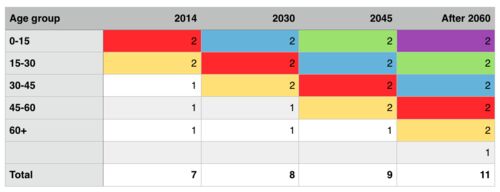For a long time I was convinced that the ever growing world population was the main cause of global warming. I thought that sustainable initiatives were futile as long as the world’s population would keep growing and that this population growth should be the main issue to target when solving global warming. However, the documentary/talk ´Don’t panic’ by Swedish professor of global health Hans Rosling has changed my view. As the title describes we should definitely not panic about the world population.
The world population has grown in a more or less exponential way. Until the 1800’s the increase was only very little, but since the industrial revolution, the population curve has started to increase very steeply. Around the 1950’s the population had grown up to 3 billion people and nowadays we are even with 7 billion people. The increase in the last fifty years has mainly been caused by the increase in Asian countries. This increase is however declining. More and more couples choose to have only 1 or 2 children. Professor Rosling shows an example of a family from Bangladesh. The father explains that he now is able to buy everything his daughters want. If he would have more children, he would not be able to afford this. In forty years the average number of babies born per family has decreased from 7 to 2.2. In the meantime the life expectancy has increased from 50 years up to 70. This actually is a global trend, in 1963 the average amount of children per family worldwide was 5 but that has been decreasing to 2.5 at this moment. Mainly the average number of children in Asian countries has dropped. Only countries in Africa still keep the average over 2.
Professor Rosling states that, according to demographers from the United Nations, the increase in population is already declining, it will take more years to go from 7 to 8 billion than it did from 6 to 7. According to these projections the world’s population will reach a surface level of 11 billion before 2100. This is due to the fact that the number of children in the world has already surfaced (at 2 billion). The following table indicates (with rounded numbers) how the population will inevitably surface. The colors show how the age groups will evolve over time. After 2060 an extra billion is added, this is due to the fact that life expectancy will also grow in the future.
Professor Rosling has showed me that population growth is in fact inevitable. The sustainable solutions need to incorporate this population growth rather than trying to minimise it. Luckily, the average income of the world’s population is growing as well. This combination creates a great opportunity for the years to come to start a sustainable transition right now. We can predict what numbers we should account for, so we can also predict the amount of energy, food and waste the system has to be able to process.
At the end of this column I want to try and link this to Texel. Texel in this case could be seen as an example of the future world. In an interview with Antoine Maartens from Urgenda, our group has found out that the population of Texel is aging rapidly. This will mean that the population will even start decreasing in a few years. We therefore can predict the amounts that a sustainable system on Texel needs to process and this gives us the opportunity to design a system that is not only environmentally sustainable, but also sustainable for the future.


